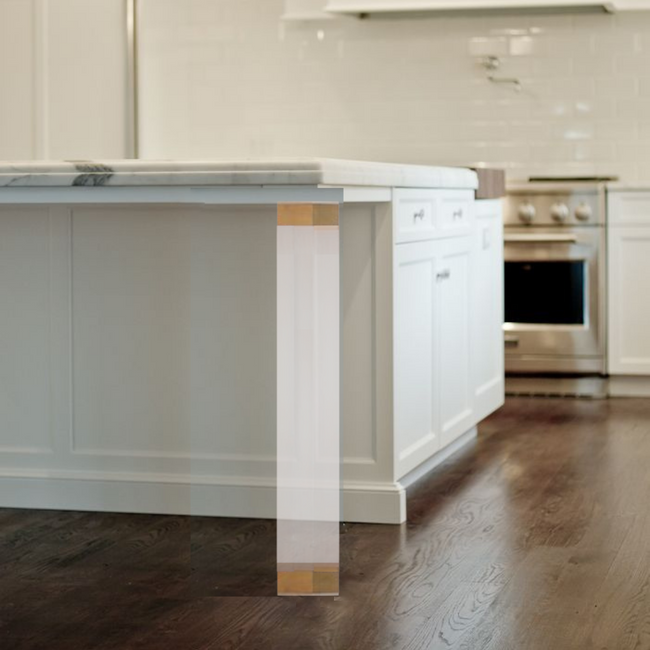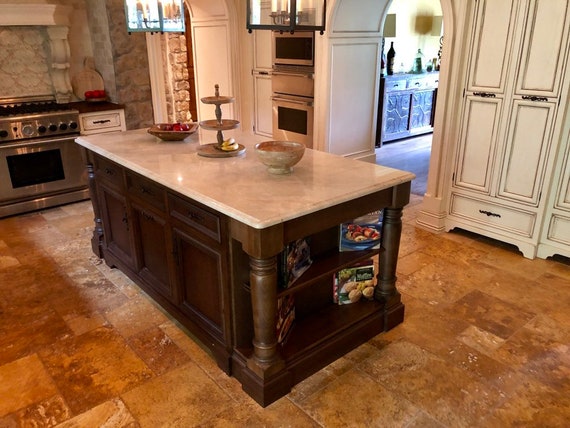Upgrade Your Kitchen with Classy Kitchen Island Leg Solutions
Wiki Article
Checking Out the Vital Functions of a Kitchen Island Leg for Your Culinary Area
The kitchen island functions as a main center in any type of cooking room, and the option of leg design is pivotal in boosting both its performance and visual allure. Comprehending the vital features of cooking area island legs-- consisting of material alternatives, style styles, and security aspects-- can considerably impact the total experience within the kitchen. As we discover these aspects, we will certainly discover how thoughtful modification and accessories can boost your kitchen area island from a mere energy to a striking centerpiece. What certain considerations should be focused on to achieve this equilibrium?Relevance of Kitchen Island Legs
Kitchen area island legs play a crucial function in both the capability and aesthetic appeals of a cooking area space. They not only support the weight of the island however additionally enhance the overall style, adding to the cooking area's aesthetic appeal. The choice of legs can dictate the design of the cooking area, be it modern-day, traditional, or rustic.Functionally, robust and correctly created legs make certain security, permitting the safe use of the island for various tasks such as cooking, dining, or amusing. Strong legs stop changing and tottering, giving a reliable surface for daily activities.
Moreover, the height and placement of the legs can affect the convenience degree for those seated at the island. A well-considered elevation can fit bar feceses or chairs, promoting a welcoming environment for gatherings.
In addition to these practical considerations, cooking area island legs can offer as a focal factor in the area (kitchen island leg). Ornamental or distinctively created legs can raise the style aesthetic, making the island a centerpiece. Hence, picking the ideal kitchen area island legs is necessary for stabilizing type and function in any culinary room
Product Options for Legs
Choosing the suitable material for kitchen island legs significantly impacts both resilience and design. Common product choices include timber, stone, and metal, each offering distinctive advantages.Wood is a popular selection due to its heat and versatility. It can be conveniently customized to match numerous design styles, from rustic to modern. Hardwoods like oak and maple give exceptional strength and long life, while softer woods can be extra prone to tear and use.
Metal legs are preferred for their smooth, contemporary aesthetic. kitchen island leg. Stainless-steel and aluminum are not just durable however additionally resistant to corrosion and corrosion, making them excellent for kitchen area settings. They can create an industrial appearance and are typically available in different coatings to complement other cooking area elements
Rock legs, such as granite or marble, include an element of high-end and security. While heavier than various other products, they provide phenomenal sturdiness and can withstand considerable weight. They might require extra assistance to ensure appropriate equilibrium.
Inevitably, the option of material should straighten with both practical demands and the overall design vision of the cooking area area, guaranteeing that the island legs enhance both energy and aesthetic appeals.
Design Designs to Think About
What design styles should be taken into consideration when choosing legs for a cooking area island? The option of leg design substantially influences the general aesthetic of your cooking space. For a modern kitchen, minimalistic and sleek leg layouts, such as stainless steel or geometric forms, can enhance the contemporary appeal, supplying a clean and clean appearance.On the other hand, typical kitchen areas gain from classic designs such as transformed or carved wood legs, which add warmth and personality. These options commonly feature elaborate information that complement vintage home furnishings. For a rustic ambiance, think about legs made from redeemed wood or wrought iron, which bring a natural, earthy high quality to the room.
If you lean in the direction of an industrial style, durable metal legs with a distressed coating may be suitable, providing an edgy yet advanced touch. In addition, farmhouse design kitchens can integrate beefy legs that stimulate a sense of strength and homeliness.

Height and Stability Elements
The elevation and stability of a kitchen island are vital aspects that straight impact its capability and customer experience. An ideal cooking area island leg need to give sufficient height to accommodate a range of tasks, from food prep work to casual dining. Usually, kitchen area islands separate 36 to 42 inches tall, lining up with typical counter and bar heights. This variety makes certain convenience for users while doing numerous tasks, thus improving Extra resources the general functionality of the room.Stability is similarly essential, especially as kitchen area islands usually function as focal factors in cooking settings. A secure leg layout decreases tottering and changing, which can bring about crashes or pain throughout usage. Materials such as solid wood, metal, or a combination thereof are commonly employed to achieve the required durability. Moreover, the leg's accessory to the island's base have to be safe and secure, making certain longevity and resilience versus the damage of day-to-day usage.
Customization and Devices
Personalization alternatives and accessories for cooking area island legs can dramatically improve both the visual charm and functionality of the area. Property owners can pick from a variety of products, including rock, metal, and wood, enabling seamless assimilation with existing kitchen area style. The choice of surface-- be it a natural discolor, repaint, or powder finishing-- more customizes the appearance, ensuring that the island matches the total design style.In enhancement to material and surface, homeowners may likewise discover the incorporation of devices such as attractive brackets, adjustable feet, or incorporated shelving. Braces can supply additional assistance while adding to a contemporary or rustic visual. Adjustable feet are specifically beneficial for unequal floor covering, making certain the island remains steady and degree, which is crucial for both security and functionality.

Conclusion
In verdict, cooking area island legs offer a crucial role in offering stability and enhancing the overall aesthetic of the culinary room. Modification alternatives and devices can boost the cooking area island, making it a distinct focal factor within the home.The kitchen area island serves as a central center in any kind of cooking room, and the selection of leg style is critical in improving both its functionality and visual allure. Recognizing the necessary functions of kitchen area island legs-- including product alternatives, style styles, and stability factors-- can significantly impact the total experience within the kitchen area.Kitchen area island legs play an essential role in both the capability and aesthetics of a cooking area area.What style styles should be considered when picking legs for a cooking area island?In final thought, kitchen island legs offer an important function in providing security and improving the overall visual of the culinary room.
Report this wiki page